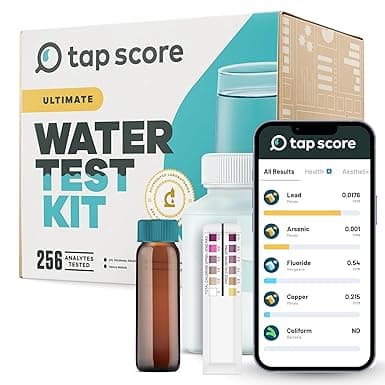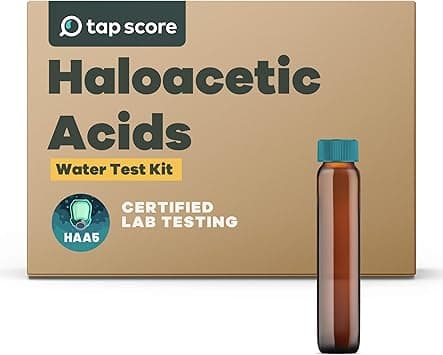West Newbury Tap Water Quality Report
West Newbury's water has 12 contaminants above EPA MCLGs. We recommend using a certified water filter.
Utility
WEST NEWBURY WATER
People Served
3,033
MCL Violations
0
Last Updated
Is West Newbury Tap Water Safe to Drink?
West Newbury's water has 12 contaminants above EPA health-based guidelines. We strongly recommend using a certified water filter to reduce exposure to these contaminants. Check our filter recommendations below for NSF-certified options that can remove the specific contaminants found in West Newbury's water.
The data below shows test results from WEST NEWBURY WATER DEPARTMENT, which serves 3,033 people in the West Newbury area. Water quality testing is conducted regularly and reported to the EPA. This report was last updated Dec 16, 2024.
West Newbury Water Quality Test Results
Key Water Quality Metrics
Contaminants Detected
⚠️ Contaminants Above EPA MCLG (12)
Arsenic
What is Arsenic?
Naturally occurring element that has both inorganic and organic forms
Health Effects
The EPA drinking water standards for arsenic are based on adverse effects to the cardiovascular, pulmonary and liver systems in drinking water with inorganic arsenic, as well as an increased risk of cancer. Long term health effects of total arsenic in drinking water include bladder, GI tract, kidney, liver, lung, pancreas and skin cancer, cardiovascular effects, pulmonary and gastrointestinal effects, ocular, immunological, neurological and reproductive effects. Arsenic found in epidemiological studies include developmental effects, socioeconomic and genotoxicity.
Affected Organs
Common Sources
Bromodichloromethane
What is Bromodichloromethane?
Member of trihalomethanes (THMs) that form in water treated with chlorine
Health Effects
Health protective benchmarks for BDCM are based on carcinogenicity and liver toxicity observed in animal studies. The EPA has classified BDCM as a probable human carcinogen. Results from animal studies also suggest that kidney, immune system, spleen, and developmental toxicity are associated with exposure to BDCM. BDCM has been shown to produce DNA changes (genotoxicity) in laboratory studies.
Affected Organs
Common Sources
Perfluorooctanoic acid
What is Perfluorooctanoic acid?
Perfluorooctanoic acid (PFOA) is a synthetic chemical that belongs to a group of chemicals known as per- and polyfluoroalkyl substances (PFAS). It is used in various industrial applications and consumer products for its water- and grease-resistant properties.
Health Effects
Exposure to PFOA has been linked to several health issues, including developmental effects in fetuses, increased cholesterol levels, liver damage, thyroid disease, and certain types of cancer.
Affected Organs
Common Sources
Bromoform
What is Bromoform?
Member of trihalomethanes (THMs) that form in water treated with chlorine
Health Effects
Health protective benchmarks for bromoform are based on liver, developmental, and carcinogenicity observed in animal studies. Results from animal studies also suggest that exposure to bromoform can also lead to liver, kidney, and developmental toxicity. Bromoform has also been shown to produce DNA changes (genotoxicity) in laboratory studies.
Affected Organs
Common Sources
Dichloroacetic Acid (DCA)
What is Dichloroacetic Acid (DCA)?
Member of haloacetic acids (HAAs) that form as byproducts when chlorine reacts with organic matter
Health Effects
Health protective benchmarks for DCA are based on evidence of increased cancer risk and liver toxicity observed in animal studies. Adverse effects to the male reproductive system have also been associated with elevated levels of DCA in animal studies. The EPA classifies DCA as a likely human carcinogen.
Affected Organs
Common Sources
Uranium
What is Uranium?
Uranium is a weakly radioactive heavy metal found naturally in bedrock and used in nuclear weapons, some ceramics, electron microscopy stains, photography toners, and certain fertilizers. Uranium is weakly radioactive because all of its isotopes (Uranium-234, Uranium-235, and Uranium-238) are unstable. Ninety-nine percent of naturally existing uranium is in the isotope form uranium-238. The EPA has established a maximum contaminant level for uranium in drinking water in response to human and animal studies indicating kidney toxicity and and increased risk of cancer.
Health Effects
Health protective benchmarks for uranium are based on adverse kidney system effects observed in both humans and animals and an increased risk of cancer. Animal studies have also shown female reproductive system and developmental toxicity, as well as genotoxicity, related to uranium exposure.
Affected Organs
Common Sources
Gross Alpha Activity
What is Gross Alpha Activity?
Gross alpha activity measures the total amount of radioactivity in a water sample emitted by decaying alpha-emitting elements, notably radioactive isotopes of uranium, radium, and radon. Alpha emitters are used to treat cancer, as an eliminator of static in paper mills and in other products like smoke detectors. Radioactive atoms release high energy alpha particles that pull electrons off of the atoms in cells. This process is called ionizing radiation, and may lead to harmful changes in cells and tissues. The toxicity of an alpha emitter depends on the amount of energy it releases and how organ systems respond to that energy. Exposure to elevated gross alpha activity is associated with increased cancer risk and genotoxicity, but toxicity to individual systems is dependent on the type of alpha emitter present.
Health Effects
Drinking water standards for gross alpha activity have been developed based on increased cancer risk associated with alpha radioactivity. Alpha radiation has been shown to produce DNA changes (genotoxicity) in laboratory studies.
Affected Organs
Common Sources
Chloroform
What is Chloroform?
Member of trihalomethanes (THMs) that form in water treated with chlorine and is generally the most abundant THM formed in drinking water
Health Effects
Health protective benchmarks for chloroform have been developed based on kidney and liver carcinogenicity observed in animal studies, and liver toxicity observed in occupational studies. The EPA classifies chloroform as a probable human carcinogen based on animal evidence, and there is additional epidemiological evidence that may increase the risk of colon and bladder cancer in humans. Results from animal studies also suggest that exposure to chloroform can cause liver, developmental and immune toxicity. Acute exposure to low levels of chloroform will cause nervous system toxicity.
Affected Organs
Common Sources
Trichloroacetic Acid (TCA)
What is Trichloroacetic Acid (TCA)?
Member of haloacetic acids (HAAs) that form as byproducts when chlorine reacts with organic matter
Health Effects
Health protective benchmarks for TCA in drinking water have been developed based on liver toxicity and carcinogenicity observed in animal studies. EPA has classified TCA as a possible human carcinogen. Developmental toxicity has also been associated with exposure to TCA based on evidence from animal studies.
Affected Organs
Common Sources
Dibromochloromethane
What is Dibromochloromethane?
Member of trihalomethanes (THMs) that form in water treated with chlorine
Health Effects
Health protective benchmarks for DBCM have been developed based on liver toxicity and carcinogenicity observed in animal studies. EPA has classified DBCM as a possible human carcinogen based on animal evidence, while IARC (International Agency for Research on Cancer) says it is unclassifiable as a human carcinogen. Kidney toxicity has also been associated with DBCM based on evidence from animal studies. DBCM has been shown to produce DNA changes (genotoxicity) in laboratory studies.
Affected Organs
Common Sources
Radium 226
What is Radium 226?
Radium-226 is a radioactive isotope of radium, which is a naturally occurring element found in uranium ores. It is a decay product of uranium-238 and is known for its radioactive properties, emitting alpha particles and gamma radiation.
Health Effects
Exposure to Radium-226 can lead to serious health issues, including an increased risk of bone cancer and other malignancies. It can accumulate in bones and tissues, leading to long-term health effects due to its radioactivity.
Affected Organs
Common Sources
Fluoride
What is Fluoride?
Naturally occurring mineral in the environment and an essential element of tooth enamel
Health Effects
Elevated levels of fluoride in drinking water can lead to dental fluorosis in children, which is the discoloration and molting away of tooth enamel. Evidence on low-dose, chronic exposure to fluoride is not definitive but has been indicated as having potential neurological impacts. Studies have clearly established that long-term exposure to high doses of fluoride, higher than typically found in US drinking water, can have adverse effects on skeletal tissue (bones and teeth), which may cause higher risk of bone fractures in seniors. Skeletal fluorosis is a debilitating condition caused by high fluoride exposure during bone development in children.
Affected Organs
Common Sources
Understanding the Data
This data comes from your local water utility testing. The bar charts compare detected levels against EPA's Maximum Contaminant Level Goal (MCLG). Contaminants above the MCLG are shown by default and may require filtration. All other tested contaminants are within safe levels and can be viewed by expanding the section above.
Recommended Water Filters for West Newbury
Based on West Newbury's water quality data, these NSF-certified filters are recommended to remove contaminants above EPA MCLGs.

Solventum Purification Inc.
3MRO401
NSF Certified:
Daily Production
11.48 gpd
Removes 15 contaminants:
Arsenic, Barium, Cadmium, Chromium (Total), Chromium (VI) +10 more

Solventum Purification Inc.
3MRO301
NSF Certified:
Daily Production
11.48 gpd
Removes 15 contaminants:
Arsenic, Barium, Cadmium, Chromium (Total), Chromium (VI) +10 more

iSpring Water Systems LLC
RCC7-BLK
NSF Certified:
Daily Production
25.41 gpd
Removes 9 contaminants:
Asbestos, Barium, Cadmium, Chromium (Total), Copper +4 more

iSpring Water Systems LLC
RCC7AK-BLK
NSF Certified:
Daily Production
25.41 gpd
Removes 9 contaminants:
Asbestos, Barium, Cadmium, Chromium (Total), Copper +4 more
Verify Your Water Quality with Independent Testing
With 12 contaminants above EPA health guidelines, independent laboratory testing provides a second opinion and can track changes over time.

SimpleLab
Advanced Home Water Test
$369
Most comprehensive home water test including all standard tests plus additional parameters for ultimate peace of mind.

SimpleLab
Standard Home Water Test
$232
Comprehensive water analysis testing over 200 contaminants including bacteria, heavy metals, and chemical compounds.

Tap Score
Haloacetic Acids (HAA9) Test
$275
Tests for disinfection byproducts formed when chlorine reacts with organic matter in water treatment.
Frequently Asked Questions About West Newbury Tap Water
West Newbury's water has 12 contaminants above EPA MCLGs. We strongly recommend using a certified water filter to reduce exposure to these contaminants. Check our filter recommendations below for NSF-certified options that can remove the specific contaminants found in West Newbury's water.